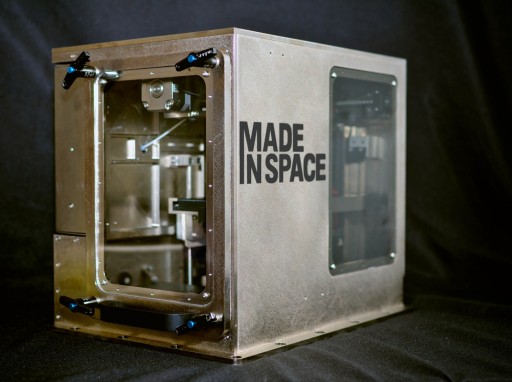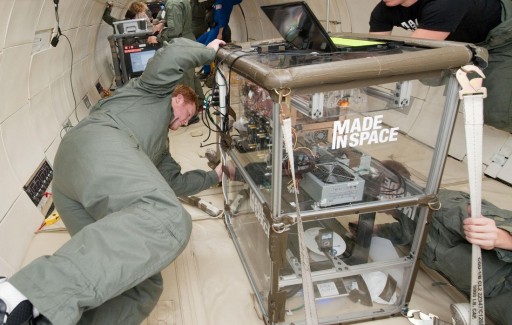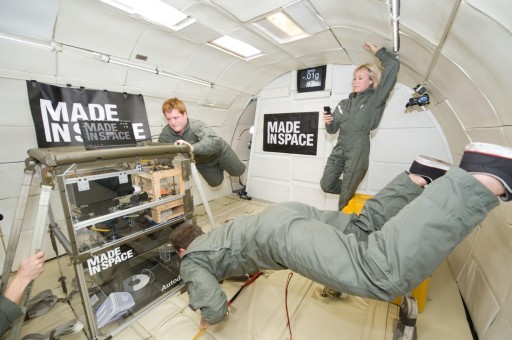The first 3D Printer ever to fly in space completed a demonstration mission to ISS known as the 3D Printing In Zero-G Technology Demonstration (3-D Printing In Zero-G) experiment. The hardware was developed by Made in Space Inc. in cooperation with NASA to explore the possibilities of 3D printing in Space for application in future Space Station missions and for Deep Space flights as part of a ‘machine shop in space’ allowing for the production of spare parts and other items needed for such missions.
3D printing, also called additive manufacturing, is the process of making a three-dimensional object of almost any shape through additive processes in which successive layers of material are laid down under computer control to generate the precise shape of the programmed model. Originating in the 1980s, 3D printing has made major advancements and is now available for virtually any material from plastics, over metal to ceramics. 3D printing technologies find many applications in industry and consumer level 3D printers are available as well.

In space flight, 3D printing has shown an increasing importance. One of the companies using 3D printing as an integral part of manufacturing is SpaceX. The SpaceX SuperDraco engine is the first fully 3D printed rocket engine featuring an inconel nozzle. A number of other components of SpaceX spacecraft can also be 3D printed as tested in various ground demonstrations.
The application of 3D printing in zero gravity has not been tested in the past, but the benefits of an operational 3D capability in space are enormous which prompted NASA to begin exploring the technology for application aboard the International Space Station. Partnering with Made in Space, NASA will test a 3D printer using relatively low-temperature plastic feedstock on ISS to learn valuable lessons before establishing an “on-demand machine shop in space, a critical enabling component for deep-space crewed missions and in-space manufacturing.”
Made in Space developed a small-sized 3D printer to fit inside the Microgravity Science Glovebox. The payload was developed to comply with all safety standards of the Space Station and completed an extensive testing campaign that included parabolic flights with over 400 parabolas to evaluate the technology for zero-G missions. Also, Electromagnetic Interference (EMI), vibration, materials compliance, human factors, electrical, and ISS interface checks were completed before NASA qualified the 3D printer for flight to ISS. In fact, the schedule for the payload was moved to the left with launch being advanced from SpX-5 to SpX-4.
Once set up aboard ISS, the payload will be used to print a number of components as part of a proof-of-concept test of the properties of melt deposition modeling additive manufacturing in the microgravity environment. The system uses acrylonitrile butadiene styrene (ABS) thermoplastic resin to produce 3D multi-layer objects. The generated objects are compliant with American Society for Testing and Materials (ASTM) standards which will allow an objective assessment of a number of parameters including tensile, flexure, compressional, and torque strength as well as layer thickness, layer adhesion, relative strength, and relative flexibility.


Multiple copies of parts will be printed to gain insight into strength variance and the implications of feedstock age. In parallel, an identical 3D printer will be used on Earth to produce the same components. These duplicated components will be used to analyze differences in properties between Earth- and space-manufactured parts which can be useful in refining 3D printing techniques for terrestrial applications.
The 3D Printer Payload uses a 28-Volt power supply and will reside within the Microgravity Science Glovebox that is used to provide conditioned air that delivers 200W of cooling capability. The payload includes polycarbonate windows for video and photo acquisition of the 3D printing process. Crew interaction with the payload is only required to remove printed parts, maintenance operations on the printer and the operation of the payload via the MSG laptop. Commanding from the ground will be available as part of the evolution of the payload.
The 3D printing experiment will lead to the development of an operational 3D printing capability aboard ISS to manufacture tools and hardware components on demand – without the need of waiting for a visiting vehicle to deliver a required component. The AMF (Additive Manufacturing Facility) payload is penciled in for deployment aboard ISS over the coming years to be used by all ISS partners.




